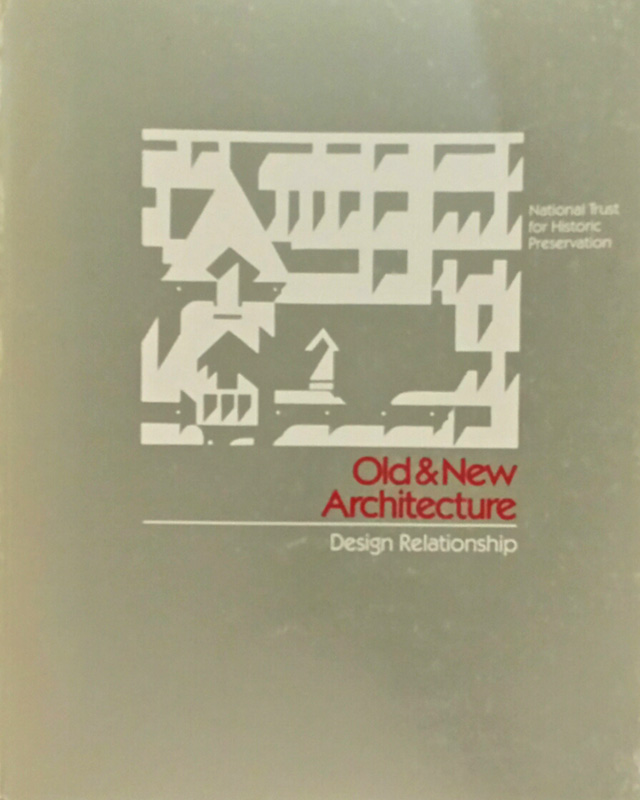Old & New Architecture
Old & New Architecture: Design Relationship
National Trust for Historic Preservation
The Preservation Press, February 1981

Paperback | 9-1/4 x 11-1/4 inches | 280 pages | 400+ illustrations | English | ISBN: 0891330976 | $15.95
Publisher Description:




Author Bio:
(Note: Books bought via these links send a few cents to this blog, keeping it afloat.)


National Trust for Historic Preservation
The Preservation Press, February 1981

Paperback | 9-1/4 x 11-1/4 inches | 280 pages | 400+ illustrations | English | ISBN: 0891330976 | $15.95
Publisher Description:
One of the most complex and controversial architectural problems of today is what relationship new architecture should bear to it's surroundings. Should new buildings imitate adjacent historical styles? Or should they starkly contrast with their neighbors to proclaim their modernity? Can formulas quantify desirable relationships between old and new? These are a few of the questions explored in this provocative book — the first to bring together the often contrasting viewpoints of 20 of the country's most respected architects and preservationists.dDAB Commentary:
Among the contributors who address the aesthetic, legal and practical problems of relating to old and new are Michael Graves, Peter Blake, Louis Sauer, Jean Paul Carlhian, Giorgio Cavaglieri, James Stewart Polshek, Samuel Wilson, Jr., Weiming Lu and Paul Goldberger. More than 400 illustrations show residential, commercial and public buildings designed to solve this age-old problem....
After writing the other day about Why Old Places Matter: How Historic Places Affect Our Identity and Well-Being by Thompson Mayes from the National Trust for Historic Preservation (NTHP), I couldn't help but take another look at Old and New Architecture: Design Relationship, which I wrote briefly about on my Unpacking My Library blog four years ago. The book, published in hardcover in 1980 and paperback the following year, documents a 1977 conference of the same name hosted by the NTHP. It examined the relationship between old and new buildings in the United States in terms of history and theory, with case studies, in terms of design reviews, and looking forward to a "future of harmonious design." Coming in the midst of Postmodernism, the theme is not very surprising. But I think it's still relevant today, since reusing old buildings is one of the most sustainable practices and therefore the interaction between old and new is of utmost importance.Spreads:
With Old and New the focus was primarily aesthetic: interventions either complemented or contrasted new with old. Peter Blake, who created a post-conference visual essay for the book, defines a few of the more creative approaches: invisible additions, such as Earl Flansburgh's underground Cornell University Campus Store; anonymous additions, as in Kevin Roche's Lehman Pavilion (among other interventions) at the Metropolitan Museum of Art; and polite deceptions, which embrace trompe l'oeil, a questionable approach in my mind. Paul Goldberger, in the "future of harmonious design" section, points out the pros and cons of mimicry, as in the addition to the Frick (which is undergoing another controversial expansion), and contrast, as in Hugh Hardy's "Weatherman" townhouse in Greenwich. Both Blake and Goldberger also single out Henry Cobb's John Hancock Tower in Boston, completed one year before the conference. Blake likes the way the tower's mirrored facade reflects H.H. Richardson' Trinity Church, though Goldberger is critical of it for the same effect. Whatever one's leanings, I wouldn't be surprised if the high-profile tower was the impetus for the conference -- and for considering if such interventions would be the future of cities (they would be, though at the expense of more creative approaches).




Author Bio:
The National Trust for Historic Preservation is the only private, nonprofit organization chartered by Congress to encourage public participation in the preservation of sites, buildings and objects significant in the United States history and culture.Purchase Links:
(Note: Books bought via these links send a few cents to this blog, keeping it afloat.)

